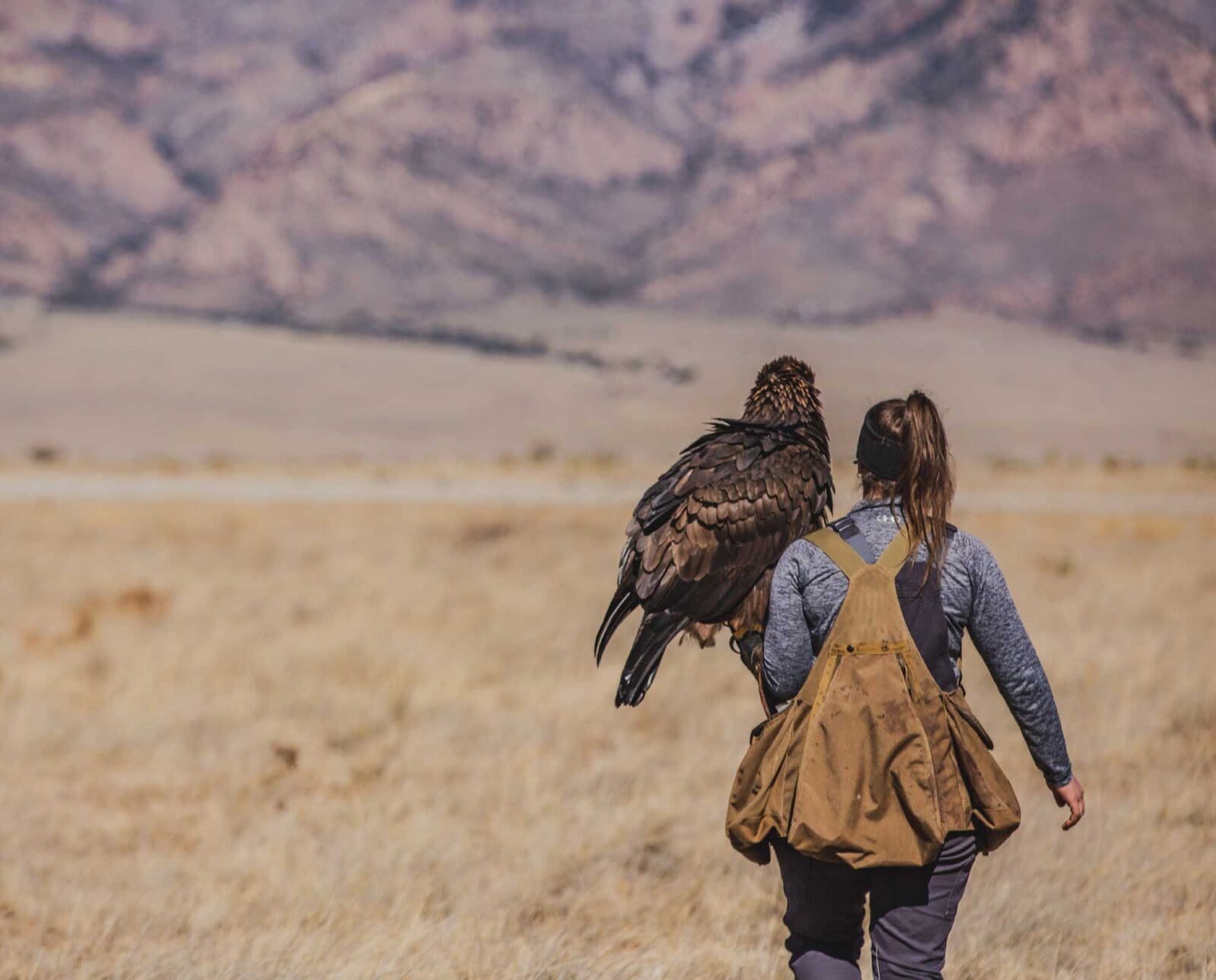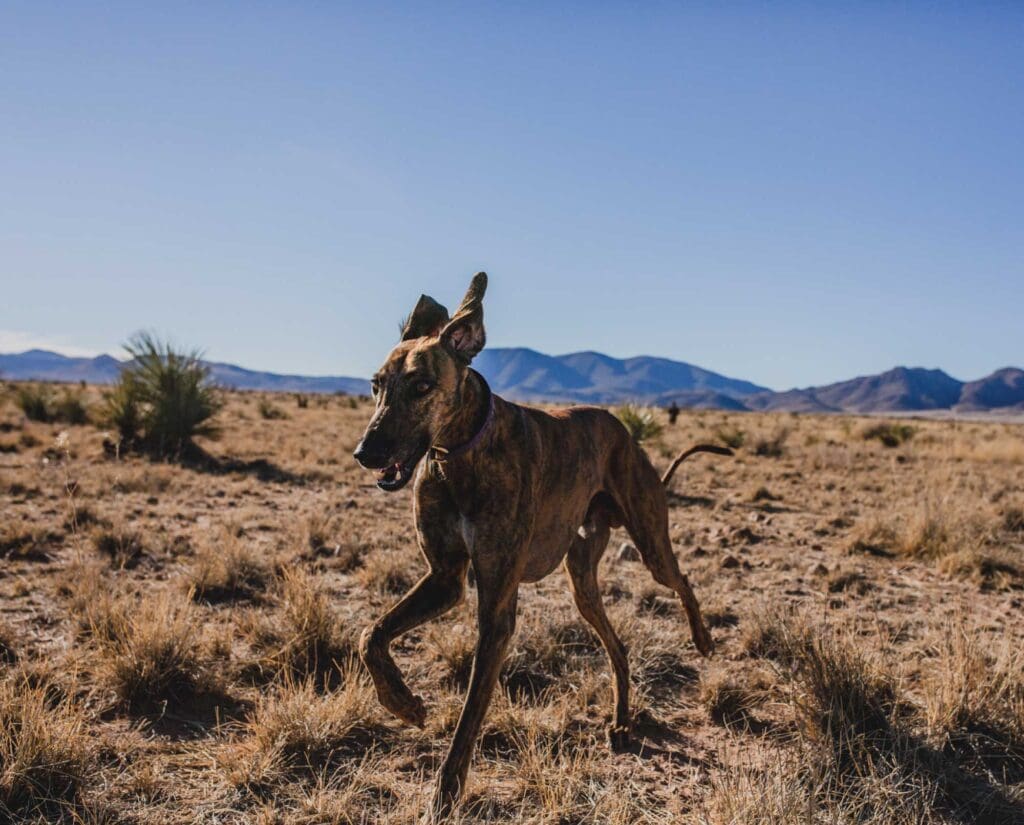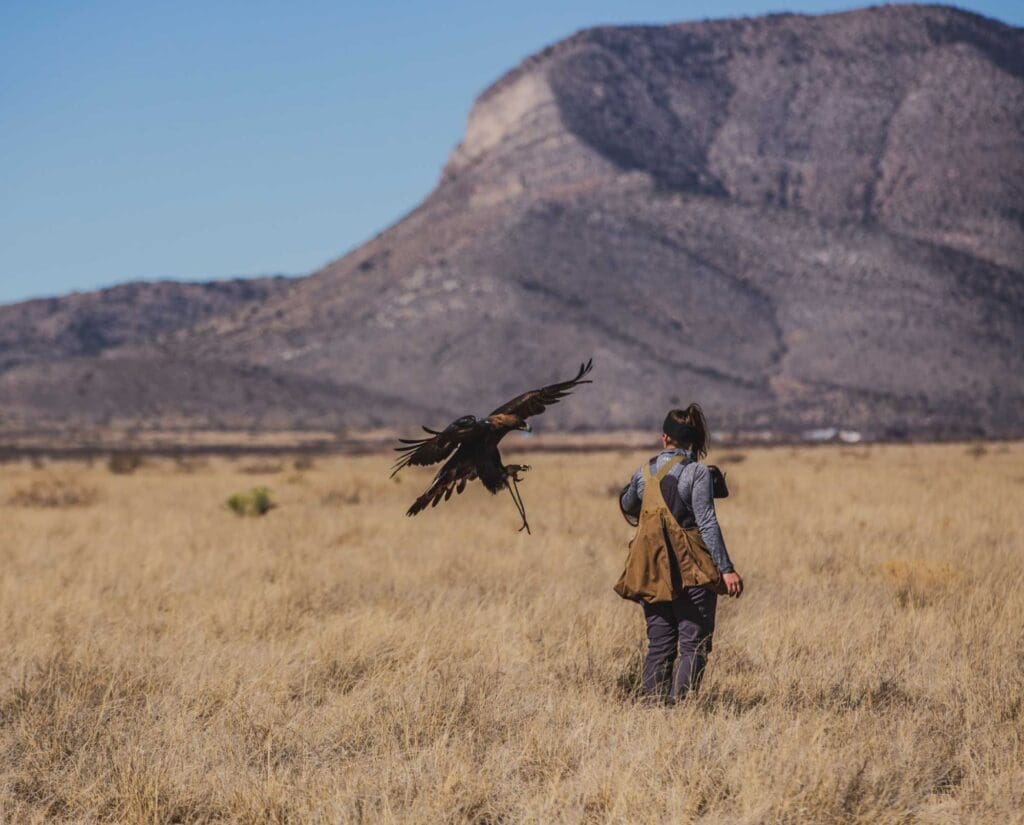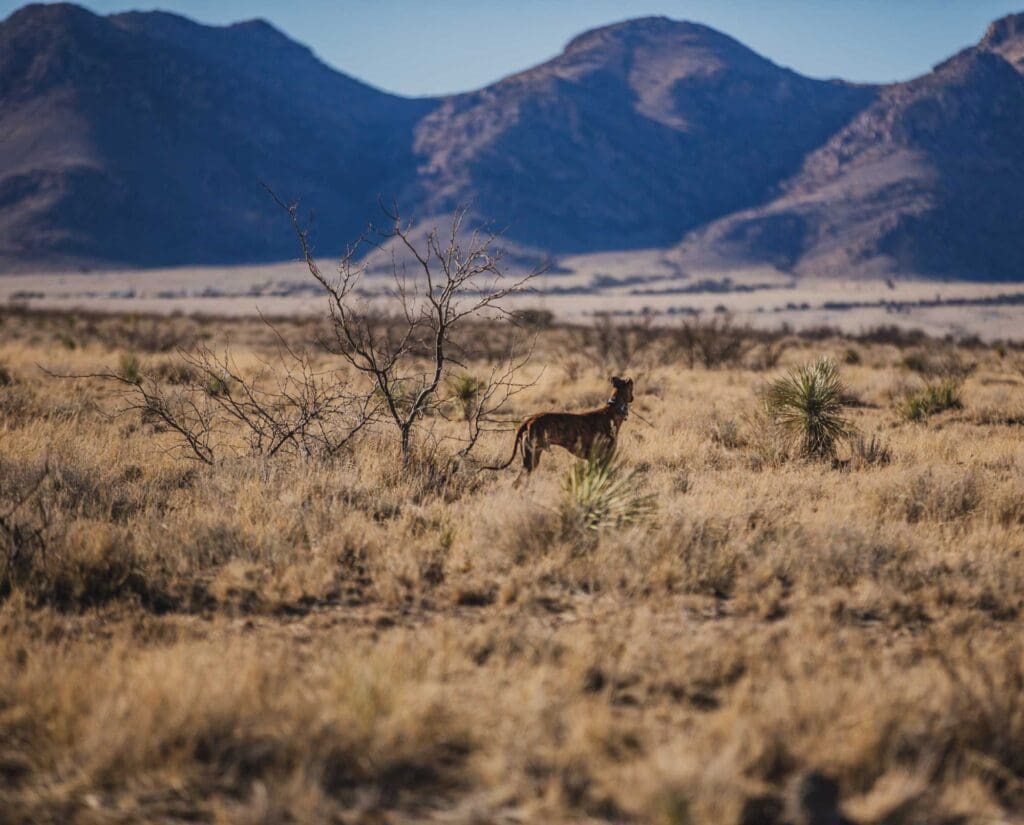Home » Hunting Dogs » Hunting with Golden Eagles and Sighthounds: Brave Eagles and Swift Dogs
Hunting with Golden Eagles and Sighthounds: Brave Eagles and Swift Dogs

Lauren McGough is an anthropologist and falconer that specializes in…
For thousands of years, trained golden eagles and sighthounds— sleek sinewy dogs built for speed and endurance—have worked together in pursuit of hare and foxes.
In Mongolia, among the Kazakh people of the Altai mountains, there is an ancient poem that lists the things every true nomad should have. Chief among these are a “brave eagle” and a “swift dog.” Of course, a fast horse and a loyal wife are important too, but there is a reason that eagles and dogs win the top spots. For thousands of years, trained golden eagles and sighthounds—sleek sinewy dogs built for speed and endurance—have worked together in pursuit of hare and foxes.
Listen to more articles on Apple | Google | Spotify | Audible
Though the origins of falconry—that is, the art and science of hunting wild quarry with a trained bird of prey—may be forever lost, it is likely that the human-eagle relationship first began in Central Asia. The region is a cradle of domestication. Much of the vast steppe, beset by permafrost, is not arable, and so nomadic herders rely on dogs, camels, horses, goats, sheep, yaks, and cows for their livelihood. Wild eagles sometimes predate on young livestock and it is not hard to imagine how an ancient herder might have been inspired to capture an eagle that he witnessed take a lamb. Perhaps it was a particularly hungry eagle, and perhaps it quickly accepted an offering of food from the herder. After a time, the herder likely realized he could set the eagle free and it would still hunt as well as return to him in hopes of a free meal. However it happened, it was an ingenious discovery.

In present-day Mongolia, golden eagles migrate from Siberia and bottleneck through western Mongolia on their annual migration to northern China each autumn. Young eagles, typically between one to three years of age (a golden eagle reaches maturity at roughly five years old) are sought by the Kazakh eaglehunters for training. These birds are young enough to readily accept training, but old enough to be able to successfully hunt on their own in the wild. It typically takes about a month of training from the time of trapping until the eagle is flying free and hunting in partnership with an eaglehunter or berkutchi, as they are known in the Kazakh language
Foxes make up a large part of the natural diet of this population of golden eagles, especially in winter. It takes little encouragement for these eagles to pursue foxes, and indeed foxes are highly prized by the berkutchi for the superb winter clothing that can be made with the luxurious fur of the fox. It takes a lot of skill to find foxes in the wilds of the Altai mountains, and even with a talented eagle, the majority will slip away and evade both human and eagle. This is where the sighthound comes in; by keeping the fox running, they give the eagle more opportunity to take the fox and thus contribute to the overall success of the hunt.
Sighthounds are found all along the former silk road, from Turkey eastward into China. For thousands of years, Salukis have been used in the Arabian Peninsula to hunt hares in partnership with falcons. In Kazakhstan it is the Tazi that is used with eagles, and in Kyrgyzstan the Taigan. There can be some debate as to how these dogs should be called and classified, but the fact remains that they are all of similar origin and, for untold generations, have hunted in partnership with birds of prey. This has given them a natural respect for raptors. Most of these dogs, though displaying tremendous determination and endurance in pursuit of game, will defer to the falcon or eagle once it has caught the quarry.
I spent two years documenting these ancient hunting traditions in Central Asia as an anthropologist and falconer and longed to try to hunt with an eagle and sighthound team in the American west. That dream began by picking up a pup in the summer of 2018 after returning from a trip flying eagles in South Africa’s Karoo desert. The pup was a beautiful tan and black brindle—he reminded me of the magical place I had just come from. I named him Karoo. Karoo’s parents were both Saluki/Greyhound crosses and had been hunted with falcons in the New Mexican desert in much the same way that Salukis hunt hares with falcons in Arabia. He had the right genes, and his parents had proven themselves with falcons.

The most amazing thing to me was how little dog training I had to do. Karoo respected birds of prey naturally—he gave them space whenever I perched them in my house or out on the lawn. He chased jackrabbits naturally; he was just a bundle of energy and enthusiasm whenever one got up and running in the grasslands. He came back to me naturally. This, I think, surprised me the most. From about a year of age, he could and would run out of sight in pursuit of jackrabbits. As soon as he was bested by the hare, he would turn around and follow the path that he had run all the way back to me. When single-minded in pursuit, how could he possibly remember his route? These days, some of his courses will go a mile or more distant, and all I have to do is stay put and watch him on the GPS unit as he makes his way back. This continues to blow my mind, but then again, I think about these dogs in the harsh desert of Arabia or on the frozen Central Asian steppes. If they couldn’t find their way back quickly, they would not have survived.
As Karoo developed, I tried to expose him to my eagles as much as possible, as well as introduce him to wild jackrabbits to chase a few days a week. Whenever possible, I allowed him to run him with other polished sighthounds to really learn what is expected of him. In the beginning, I’d have to be careful to only let him have one hard run on a jackrabbit, since their desire to run can outstrip their fitness level and lead to overheating and injuries. Now, at three years old, he can manage 3-5 hard runs in an outing.
I’ve been surprised to learn how difficult it is for a solo sighthound to take a jackrabbit. He’s taken eight on his own since I’ve had him, but it is certainly an exception rather than the rule. This is actually a benefit to me as a falconer, since my aim is to orchestrate a hunt where Karoo keeps the jackrabbit running and the eagle is able to come in from above and take it. On those rare days where Karoo catches the hare, I am always rather shocked to see that he wants to bring it back to me. These dogs are such incredible athletes! A 45lb Karoo packs back an 8lb hare often a mile or more and then drops it at my feet, where he is happy to just relax and exist there with me in the moment.

Once Karoo was confidently and effectively chasing jackrabbits, it was time to introduce the eagle in a hunting situation. When hunting with my eagle, I fly her from a soar. This most closely mimics their wild habits—how often do you see an eagle as a tiny silhouette riding the wind currents? Although it takes a lot of time to teach an eagle to loyally wait on the wind currents above you while you work the ground below for hares, the rewards are big. You might see a thousand-foot stoop with the eagle coming down at over a hundred miles an hour. Eagles aren’t quite the speed demons that falcons are, who have been clocked at 242 mph in a stoop. Using small GPS devices, 120 mph seems to be the higher end that my eagles can achieve. But it has to be said, even at that slower speed, the wind screaming through their feathers in a dive has to be heard to be believed. You can only stand there, wide-eyed with your heart in your throat, as you watch them plummet!
In the American west, jackrabbits have co-evolved over millions of years with eagles in an incredible evolutionary arms race. When an eagle is soaring, jackrabbits pin down and sneak away. Even when flushed and running, they’ll freeze in cover and disappear from the eagle. While a wild eagle has all daylight hours to try and catch a jackrabbit off its guard, as a falconer I am out for an hour or two a day, so it is the sighthound that helps gives the eagle an edge against these savvy hares, especially when the eagle is still learning its hunting technique.
My eagles love the windiest days for soaring. We drive out to the field, typically a row of hills with the wind pushing against the hills to provide easy lift. I put the GPS on the eagle and set her atop my car while Karoo and I start walking towards the hills. It typically only takes a few minutes for the eagle to launch and start finding lift. Before long, she’s several hundred feet above Karoo and me, her head cocked down watching us. Then, it is up to us to flush a jackrabbit! I walk through likely areas of cover while Karoo stays about 50 yards in front of me, stopping to scan the landscape for movement every so often. And then if you are lucky, it happens!
I remember being so nervous the first time I had Karoo hunting with an eagle that I’d trained. A jackrabbit appeared and started running towards the hills. Karoo immediately saw it and was all speed and angles as he took off after it. Since he is about half greyhound, I came to realize that Karoo had a quite a bit of speed. In a full-out sprint after a jackrabbit, I’ve regularly clocked him on the GPS at 42 mph. There were areas of dense yucca and cholla on these foothills, but Karoo kept the jackrabbit running past these spots of easy cover. I looked up to see my eagle start to fold. She skimmed down across the hillside, picking up tremendous speed. I saw the jackrabbit with its ears tucked in a full out sprint, Karoo about 15 feet behind it, and then I saw my eagle come in so fast that they seemed to be in slow motion! The eagle collided with the jackrabbit, her momentum taking her and the hare end-over-end in a cloud of dust. It settled and there she was, proudly sitting atop a dead jackrabbit. I can’t put that feeling into words! We are three totally different species working towards the same goal, and it leaves me in awe every single time it happens.
Karoo laid down near the eagle as she started to pluck the jackrabbit. I let the eagle relax and eat some of the warm jackrabbit meat—eagles particularly love the heart and lungs—and then I stepped her off to a nice piece of meat in my glove. Once she was preoccupied with eating what was in my glove, I slipped the hare into my bag and we all walked back to the car, together and contented.
Since that first success, we’ve had many flights play out in many different ways. There are the jackrabbits that manage to outmaneuver Karoo and then dodge the eagle as she comes in—you can’t help but applaud and respect the mighty blacktailed jackrabbit after seeing that! Another memorable flight started with a hare slipping out behind Karoo and me, headed for the hills. I didn’t notice until I saw the eagle tuck up for her stoop. She hit the ground as the hare juked her and ran uphill. The eagle opened her wings in the strong wind and was instantly taken back up over the hare. She made another try but was similarly juked. At this point Karoo arrived on the scene, sprinting uphill and keeping the hare running as the eagle put in a third and fourth attempt. Lifting up once more, the hare neared the crest of the hill as the eagle slammed in successfully on her fifth attempt. Interspecies tenacity and teamwork!
What captivates my imagination with this type of hunting is that I never know what incredible scene I might see play out in front of me. The hare, the sighthound, and the eagle are all astounding athletes in their own way, and any one of them can win the day.
This article originally appeared in Hunting Dog Confidential Volume 2.1 with photography by Adam Pecht
Lauren McGough is an anthropologist and falconer that specializes in the nomadic cultures of Central Asia and the art of hunting in partnership with eagles. She received her PhD from the University in St Andrews in Scotland, and has spent several years living abroad in South Africa, Mongolia and Europe to fly eagles. She currently lives in Oklahoma, where she runs her sighthound Karoo and flies her golden eagle Vega.




This is absurdly cool, great article, what I would give to witness this.
I have watched several documentaries on the peoples of the Mongolian Steppes hunting with raptors. It is an incredible feat of cooperation. Thank you for sharing this synonymous experience you have recreated here in the USA. Kick ass!
My 13 year old grandson has been mesmerized by eagles for years. I have taken him to Ohio Falconry school twice and he has had an amazing experience hunting with hawks. I have toyed with the idea of taking him to Mongolia to see the Golden Eagle festival but the trip seems daunting. I wonder if there is an opportunity to learn about hunting with Golden Eagles in USA.